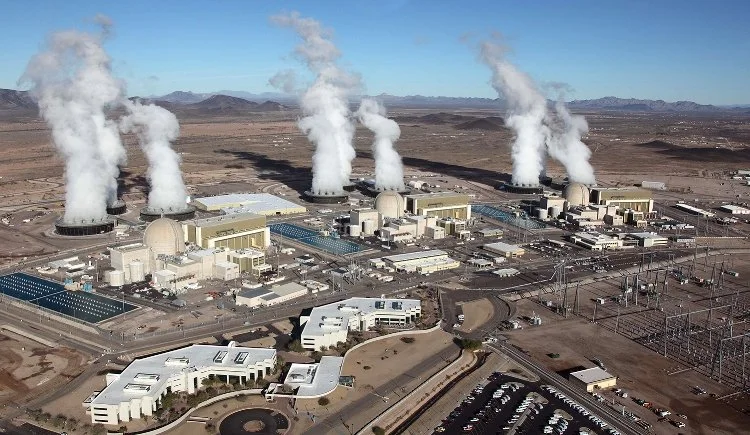Energy In Arizona
Navajo Power Generating Station, supplied by Arizona's only coal mine, Kayenta
With concern about climate change at an all-time high, the Palo Verde Nuclear Energy Plant generates a lot of excitement as a carbon-free energy source. It’s been the top power producing facility for 24 consecutive years and in 2015 set the production record to become the #1 nuclear power producing plant in the world.
Palo Verde produces power for 4 million people in 4 states. In addition, it produces 35% of Arizona’s electrical energy. Seven power companies share ownership of it, including APS, SRP, and power companies in New Mexico, Southern California, and Texas. seven power companies own it, but since APS owns 30%, it takes care of most plant maintenance operations.
Palo Verde Nuclear Power Plant
Arizona's Palo Verde Nuclear Generating Station was built in 1986 and rated at 3,937 net megawatts, is the largest nuclear power plant and the second largest power plant of any kind in the nation. While other nuclear power plants are located next to a body of water, the innovative system at Palo Verde uses wastewater from Phoenix as it’s core-cooling water source. 20,000 gallons per minute are required for each of the three reactors at the station. It uses 80 million gallons a day when operating at full capacity.
An Arizona wastewater treatment plant on 91st Ave, and another in Tolleson supply the Palo Verde with the wastewater which provides 97% of the water it needs. The other 3% comes from groundwater.
Even though we have an innovative nuclear power program, Arizona also ranked second in the nation in utility-scale electricity generation from solar energy in 2014. As solar energy costs drop, more homes and small businesses will turn to solar energy as their primary source of power. Even though Arizona is the 15th most populous state, we ranked 44th in the nation in per capita energy consumption in 2013, partly because of the state’s small industrial sector.
The number of solar energy users in Arizona continues to grow exponentially as the price drops.
Arizona's only operating coal mine, Kayenta, on the Navajo and Hopi reservations, supplies the the Navajo Generating Station's three 750-megawatt units with the 7-to-8 million short tons they burn annually.
Arizona's Renewable Environmental Standard requires 15% of the state’s electricity consumed in 2025 to come from renewable energy resources; in 2014, 8.9% of Arizona’s net electricity generation came from renewable resources, primarily from the Glen Canyon and Hoover Dams.
Twenty-five percent of the energy consumed in Arizona homes is for air conditioning, which is more than four times the national average of 6 percent, according to the U.S. Energy Information System's Residential Energy Consumption Survey.
One thing is for certain, though: with Arizona’s utility companies making noises about new demand rate structuring for residential homes, more and more customers will be looking at solar as a better option. Even without the new rate structuring, the number of residences with solar has risen exponentially in the past year because the price has dropped to a competitive level.
While residents aren't watching, the solar companies and electric companies are quietly negotiating how to balance commerce, prices and green energy without making solar into a political issue. This means that changes are coming, and therefore, energy in Arizona is something that all of us should be watching.



